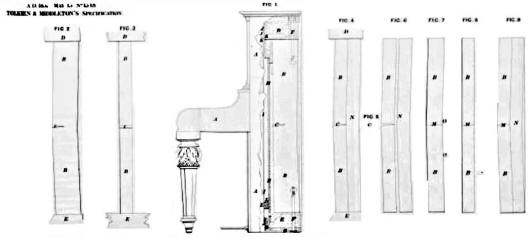in London
![]()

![]()
"PROVISIONAL
SPECIFICATION left by the said Henry Tolkien and Joseph Middleton at the
Office of the Commissioners of Patents, with their Petition, on the 13th
May 1857.
WHEREAS Her most Excellent Majesty Queen
Victoria, by Her Letters Patent, bearing date the Thirteenth day of May,
in the year of our Lord One thousand eight hundred and fifty-seven, in
the twentieth year of Her reign, did, for Herself, Her heirs and
successors, give and grant unto us, the said Henry Tolkien and Joseph
Middleton, Her special licence that we, the said Henry Tolkien and
Joseph Middleton, our executors, administrators, and assigns, or such
others as we, the said Henry Tolkien and Joseph Middleton, our
executors, administrators, and assigns, should at any time agree with,
and no others, from time to time and at all times thereafter during the
term therein expressed, should and lawfully might make, use, exercise,
and vend, within the 'United Kingdom of Great Britain and Ireland, the
Channel Islands, and Isle of Man, an Invention for “IMPROVEMENTS IN
PIANOFORTES,” upon the condition (amongst others) that we, the said
Ilenry Tolkien and Joseph Middleton, our executors or administrators, by
an instrument in writing under our, or their, or one of their hands and
seals, should particularly describe and ascertain the nature of the said
Invention, and in what manner the same was to be performed, and cause
the same to be filed in the Great Seal Patent Office within six calendar
months next and immediately after the date of the said Letters Patent.
Image : English Patents of Inventions, Specifications, 1857, p. 7/25 But in order that our said Invention may be more fully understood and readily carried into effect, we now proceed to describe it by the aid of the accompanying Drawings, reference being had to the letters and figures thereon marked (that is to say) :
Fig. 1 represents a side elevation,
partly in section, of a pianoforte with our improvements attached;
A, A, case or body of the instrument; Bracings formed in accordance with our improvements may be constructed in one or more parts, with or without the employment of metallic substances, and the said parts united or held together by bolts, pins, screws, or otherwise ; bracings in like manner may also be formed with convex front surfaces, as above mentioned, by substituting in place of the wedge the requisite angular joint, as represented at L, L, Figs. 7, 8, and 9. In conclusion to the foregoing description we would bere briefly note, that the construction of the bracings may be effected in various ways, such as being sawn partly through when in one piece, as at Figs. 1, 2, and 3, or united when in two parts through the medium of a metallic back, as at Figs. 7 and 8, but we prefer the mode of forming them of several parts, as represented at Figs. 4, 5, and 6, in which case we cause the back portions to be bent to the requisite angle, by placing the centres thereof over a saddle or fulcrum so as to depress the ends, or by any other suitable method, by which means the two front portions may be readily bolted or secured thereto, and the wedge inserted so as to maintain the whole in its flexed or angular position; and we would further note that our said improvements are applicable to all the various descriptions of pianofortes of the usual construction. Having now fully described the nature of this our said Invention, and the manner in which the same is to performed and carried into effect, we would bave it clearly understood that we do not by any means confine our- 5 selves to the precise details herein-before set forth and described, as the same might be varied without departing from the general princple of these our said improvements ; but that which we do claim as new and of our said Invention is, the general construction and arrangement of truss convex bracings in the manner and for the purposes herein-before set forth and 10 described. In witness whereof, we, the said Henry Tolkien and Joseph Middleton, have hereunto set our hands and seals, this Thirteenth day of November, in the year of our Lord One thousand eight hundred and fifty-seven. HENRY TOLKIEN. (L.s.) - JOSEPH MIDDLETON. (L.s) - Witness, F. R. DARKIN CAMPBELL, Clerk to Messrs. Weatherdon & Co., 20 77, Chancery Lane." English Patents of Inventions, Specifications, 1857, p. 7-
For references
see page
| |
